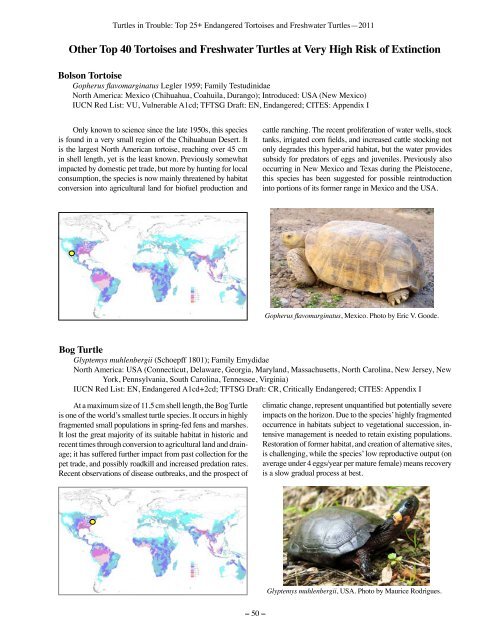Turtles in Trouble: The World's 25+ Most Endangered - Wildlife ...
Turtles in Trouble: The World's 25+ Most Endangered - Wildlife ...
Turtles in Trouble: The World's 25+ Most Endangered - Wildlife ...
- No tags were found...
Create successful ePaper yourself
Turn your PDF publications into a flip-book with our unique Google optimized e-Paper software.
<strong>Turtles</strong> <strong>in</strong> <strong>Trouble</strong>: Top <strong>25+</strong> <strong>Endangered</strong> Tortoises and Freshwater <strong>Turtles</strong>—2011Other Top 40 Tortoises and Freshwater <strong>Turtles</strong> at Very High Risk of Ext<strong>in</strong>ctionBolson TortoiseGopherus flavomarg<strong>in</strong>atus Legler 1959; Family Testud<strong>in</strong>idaeNorth America: Mexico (Chihuahua, Coahuila, Durango); Introduced: USA (New Mexico)IUCN Red List: VU, Vulnerable A1cd; TFTSG Draft: EN, <strong>Endangered</strong>; CITES: Appendix IOnly known to science s<strong>in</strong>ce the late 1950s, this speciesis found <strong>in</strong> a very small region of the Chihuahuan Desert. Itis the largest North American tortoise, reach<strong>in</strong>g over 45 cm<strong>in</strong> shell length, yet is the least known. Previously somewhatimpacted by domestic pet trade, but more by hunt<strong>in</strong>g for localconsumption, the species is now ma<strong>in</strong>ly threatened by habitatconversion <strong>in</strong>to agricultural land for biofuel production andcattle ranch<strong>in</strong>g. <strong>The</strong> recent proliferation of water wells, stocktanks, irrigated corn fields, and <strong>in</strong>creased cattle stock<strong>in</strong>g notonly degrades this hyper-arid habitat, but the water providessubsidy for predators of eggs and juveniles. Previously alsooccurr<strong>in</strong>g <strong>in</strong> New Mexico and Texas dur<strong>in</strong>g the Pleistocene,this species has been suggested for possible re<strong>in</strong>troduction<strong>in</strong>to portions of its former range <strong>in</strong> Mexico and the USA.Gopherus flavomarg<strong>in</strong>atus, Mexico. Photo by Eric V. Goode.Bog TurtleGlyptemys muhlenbergii (Schoepff 1801); Family EmydidaeNorth America: USA (Connecticut, Delaware, Georgia, Maryland, Massachusetts, North Carol<strong>in</strong>a, New Jersey, NewYork, Pennsylvania, South Carol<strong>in</strong>a, Tennessee, Virg<strong>in</strong>ia)IUCN Red List: EN, <strong>Endangered</strong> A1cd+2cd; TFTSG Draft: CR, Critically <strong>Endangered</strong>; CITES: Appendix IAt a maximum size of 11.5 cm shell length, the Bog Turtleis one of the world’s smallest turtle species. It occurs <strong>in</strong> highlyfragmented small populations <strong>in</strong> spr<strong>in</strong>g-fed fens and marshes.It lost the great majority of its suitable habitat <strong>in</strong> historic andrecent times through conversion to agricultural land and dra<strong>in</strong>age;it has suffered further impact from past collection for thepet trade, and possibly roadkill and <strong>in</strong>creased predation rates.Recent observations of disease outbreaks, and the prospect ofclimatic change, represent unquantified but potentially severeimpacts on the horizon. Due to the species’ highly fragmentedoccurrence <strong>in</strong> habitats subject to vegetational succession, <strong>in</strong>tensivemanagement is needed to reta<strong>in</strong> exist<strong>in</strong>g populations.Restoration of former habitat, and creation of alternative sites,is challeng<strong>in</strong>g, while the species’ low reproductive output (onaverage under 4 eggs/year per mature female) means recoveryis a slow gradual process at best.Glyptemys muhlenbergii, USA. Photo by Maurice Rodrigues.– 50 –







![RaLand / SeaScape [PDF] - Wildlife Conservation Society](https://img.yumpu.com/49974326/1/190x245/raland-seascape-pdf-wildlife-conservation-society.jpg?quality=85)








